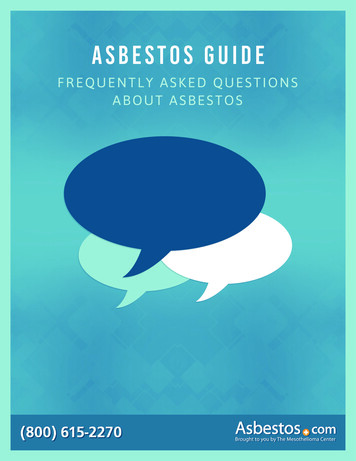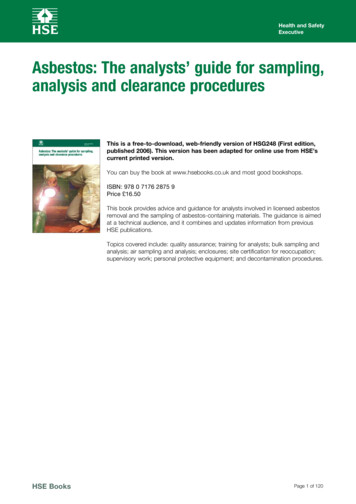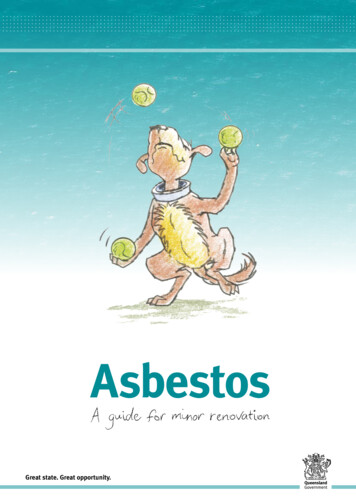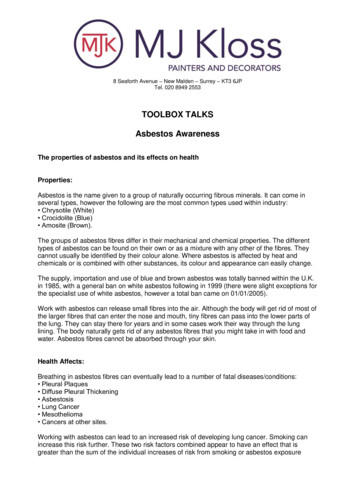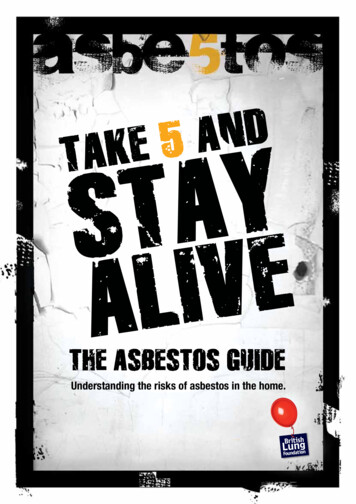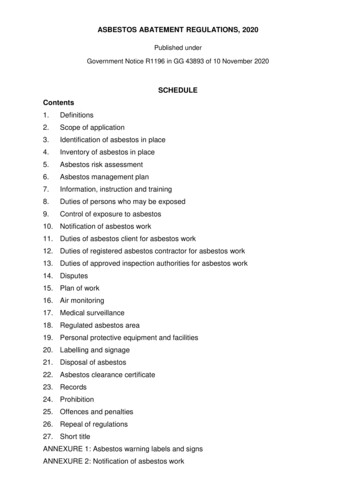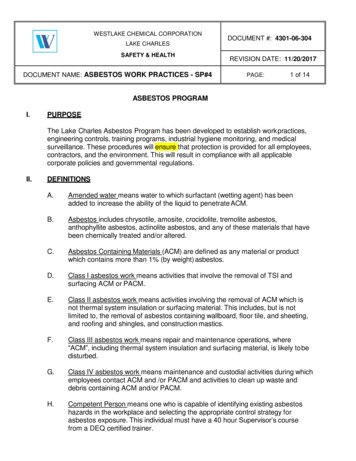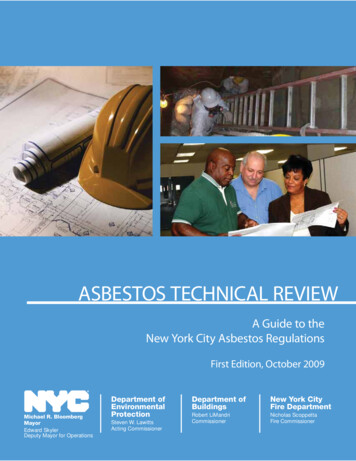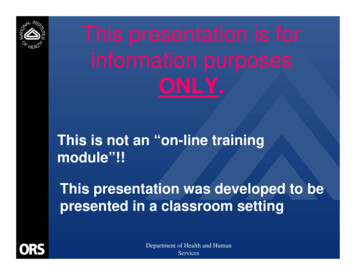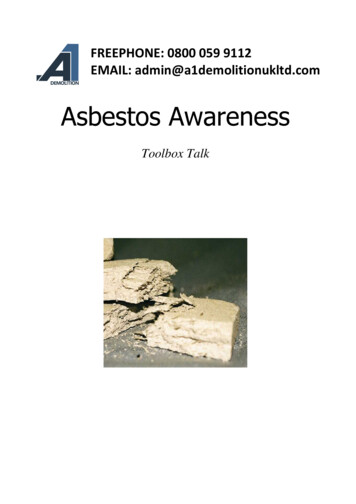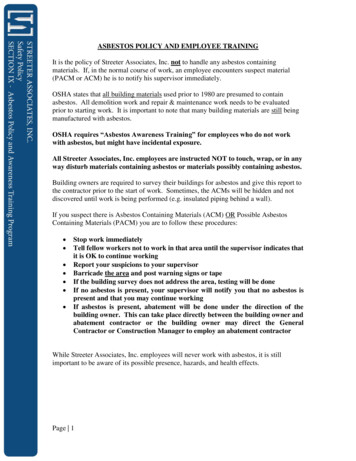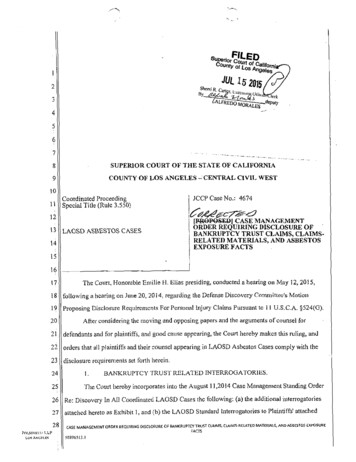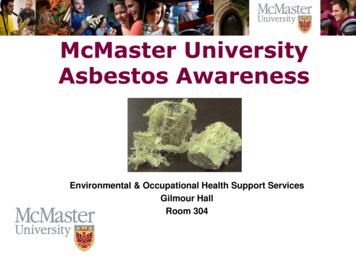
Transcription
The Campaign for McMaster UniversityThe Campaign for McMaster UniversityMcMaster UniversityAsbestos AwarenessEnvironmental & Occupational Health Support ServicesGilmour HallRoom 304
The Campaign for McMaster UniversityThe Campaign for McMaster UniversityTopics Covered What is asbestosProperties of asbestosTypes of asbestosUses of asbestosHistory of asbestosHealth hazards of asbestosActivities resulting in potential asbestosexposure Asbestos regulations McMaster University’s Responsibilities Where to get help
What Is Asbestos Asbestos is a name given to a group of minerals which occur naturally as masses of long silky fibers.Asbestos is resistant to abrasion, inert to acid andalkaline solutions, and stable at high temperatures.Asbestos fibers are woven together or incorporatedwithin other materials to create many products.The needle-like fibres seemed like nature's perfectgift. Fireproof, indestructible and cheap, from the1940s to the 1970s, asbestos was everywhere. It waswoven into clothes and used to insulate buildings.
What Is Asbestos Asbestos is a natural mineral which was formed during intense volcanic activities millions of yearsago.Late 1800‟s asbestos was mined commercially for itsfireproof and virtually indestructible properties.
Properties of Asbestos Naturally occurringfibrous minerals Good tensile strength Flexibility Heat resistant Electrical resistance Good insulation Chemical resistant
Types of AsbestosThree Most Common Types Chrysotile “White Asbestos” Amosite “Brown Asbestos” Crocidolite “Blue Asbestos”Three Other Categories Not Common Tremolite in vermiculite) Actinolite(possible contaminant Anthophyllite
Chrysotile (White Asbestos) Fine, silky, flexible white fibers (the most commonlyused asbestos in the United States and Canada).Current evidence suggests that Chrysotile is the mostcommon form of asbestos and less hazardous from ahealth perspective than Amosite or Crocidolite.
Amosite (Brown Asbestos) Straight, brittle fibers that are light grey to pale brown(the most commonly used in thermal systeminsulation).
Crocidolite (Blue Asbestos) Straight blue fibers
Match the Picture with the AsbestosType Crocidolite Chrysotile Amosite(Do a scramble - where pics move to the right type?)
Uses of AsbestosAsbestosinsulated pipe inutility space Thermal system Sprayed-on fireproofing materialinsulationSurfacing materialsReinforcement ofmaterialsFireproofingAcoustic and decorativeplasterTextiles
The Campaign for McMaster UniversityThe Campaign for McMaster UniversityUses of Asbestos Friction materials (brakes,clutches, etc.) Asphalt and vinyl felts Papers and adhesives Flooring and roofingmaterials Filters, sealants, caulk,and gaskets
Sprayed fireproofing
Some Asbestos-Containing Materials Cement Pipes Spray-Applied Insulation Cement Wallboard Blown-in Insulation Cement Siding Fireproofing Materials Asphalt Floor Tile Taping Compounds (thermal) Vinyl Floor Tile Packing Materials (for wall/floorpenetrations) Vinyl Sheet Flooring High Temperature Gaskets Flooring Backing Laboratory Hoods/Table Tops Construction Mastics (floor tile, carpet, Laboratory Glovesceiling tile, etc.) Fire Blankets Acoustical Plaster Fire Curtains Decorative Plaster Textured Paints/Coatings Ceiling Tiles and Lay-in Panels
Some Asbestos-Containing Materials Elevator Equipment Panels Chalkboards Elevator Brake Shoes Roofing Shingles HVAC Duct Insulation Roofing Felt Boiler Insulation Breaching Insulation Base Flashing Thermal Paper Products Fire Doors Ductwork Flexible Fabric Connections Caulking/Putties Cooling Towers Adhesives Pipe Insulation (corrugated air-cell, Wallboardblock, etc.) Heating and Electrical Ducts Electrical Panel Partitions Electrical Cloth Electric Wiring Insulation Joint Compounds Vinyl Wall Coverings Spackling Compounds
True or FalseAsbestos can be found in the ceiling space of olderbuildings.
History of Asbestos1930‟sMajor use began1940‟sUse increased duringpost-war building boom1950‟s-60‟s 40-50,000 tons per year used inOntario1970‟sConcern over health effects
History of Asbestos(continued)1970‟s-80‟s Specific prohibitions legislated1980‟s -90‟s Removed from many hospitals, schoolsTodayMuch still remains andcontinues to be a risk to workers inmaintenance, renovation, repair, anddemolition if not managed properly.
Asbestos is an Inhalation Hazard Breathable fibers aredeposited in the alveoli, theending small air sacs in thelungs.Pleura Body‟s defense mechanismscannot break down the fibers. Fibers cause damage torespiratory system.Alveoli
Asbestos-related Diseases Asbestosis Usually symptoms take15 to 30 years or more todevelop. Health effects fromasbestos exposure maycontinue to progresseven after exposure isstopped. Mesothelioma Lung Cancer Other cancers
Asbestos-related DiseasesHealthy LungMesothelioma
What does Friable mean? Friable: can be easilycrumbled or crushedby hand, releasingfibers into the air Very small fibers stayin the air for longperiods Damaged ordeteriorated ACMincreases friability
Non Friable Asbestos Non-friable (not easily crushed by hand) asbestosexamples include transite, mastic, asbestos gaskets,tracer tape, old floor tiles, etc. The above examplesare based on the materials being in good shape.
Test your knowledge!You enter a room and find that there has been a roofleak and the asbestos containing ceiling tiles havebecome wet and have fallen to the floor breaking intoseveral pieces.Would you classify the ceiling tiles as friable or nonfriable?
How asbestos fibres breakAsbestos breaks along its axis.
Fibre length is importantGreater 5µmLess than3 µm Fibre length determines health effects Respirable fibres are usually less than3 µm in diameter Concern with fibresgreater than 5 µm Fibres can penetrateup to the alveoli
MICROMETER (µm) One millionth of a meter Can see fibres greater than 100 µm diameter Human hair is about 50 µm in diameterASBESTOS FIBREHUMAN HAIR
How do asbestos fibers get in the air? Mechanical action on ACM (cutting,sawing, grinding, sanding, drilling,buffing) Disturbing/breaking ceiling tiles Removing/replacing insulation Disturbing sprayed-on asbestos Damaged/deteriorated ACM Asbestos abatement projectWater damage, deterioration
Asbestos Regulations - Ontario Ontario OH&S Act –contains the regulationsfor DesignatedSubstances Regulation 278/05Asbestos on ConstructionProjects Regulation 490/09,previously Regulation279/05
University Responsibility Maintain accurate inventory ofAsbestos on campus Follow Regulation 278/05 whenremoving asbestos Provide information under the „Rightto Know‟ Conduct occupant meetings prior toconstruction Conduct awareness sessions forJHSC members or others
Risk Management Manual Asbestos Management Control Program RMM #401Outlines roles and responsibilities ofsenior managers, facilities services,supervisors, project managers,contractors, EOHSS/FHSc, and JHSCwith respect to asbestosDetails abatement procedures,sampling, personal protection, trainingrequirements, documentation, andemergency work practices
Exposure Control Type 1 – non-friable Wet methods Prompt disposal Housekeeping Type 2 – friable small Unventilated enclosure Type 3 – friable large Ventilated enclosure, isolationHEPA vacuum unitsHEPA filter high efficiencyparticulate air filter
Air Monitoring Air monitoring is required duringType 3 projects only. Conducted at the start, during andfollowing a project. Clearance is given prior toenclosures being torn down. The allowable limit for asbestosfibres is 0.01 fibres per cubiccentimeters.
Questions?Contact EOHSS at ext 24352orFacility Services ext 24740
Some Asbestos-Containing Materials Cement Pipes Cement Wallboard Cement Siding Asphalt Floor Tile Vinyl Floor Tile Vinyl Sheet Flooring Flooring Backing Construction Mastics (floor tile, carpet, ceiling tile, etc.) Acoustical Plaster Decorative Plaster Textured Paints/Coatings Ceiling Tiles and Lay-in Panels Spray-Applied Insulation
